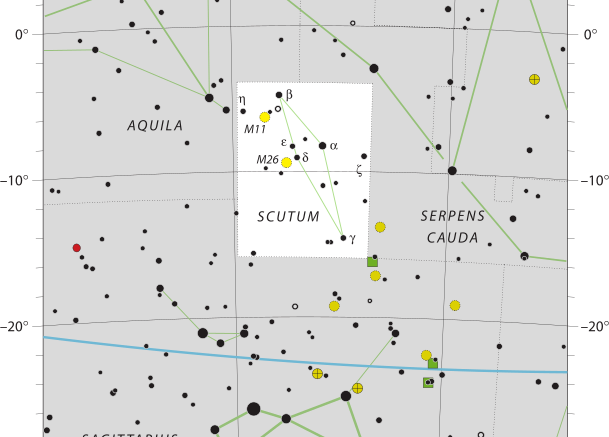Originally named Scutum Sobiescianum by Johannes Hevelius in 1684, Scutum is a small constellation. The name Scutum means ‘shield’ in Latin for shield, and it lies entirely in the southern celestial hemisphere. It is one of the 88 IAU designated constellations, with its four brightest stars form a narrow diamond shape.
Coincidentally, the Chinese also associated these stars with battle armor, incorporating them into the larger asterism known as Tien Pien, i.e., the Heavenly Casque (or Helmet).[1]
The space probe Pioneer 11 is moving in the direction of this constellation. It will not be nearing the closest star in this constellation for over a million years at present speed, by which time its batteries will be long dead.
The best time to view the constellation is in August, while the constellations will be visible in May to October.
| Applicable Information | |
| Visibility In Pacific Northwest | May to October |
| Best Times To View | August |
| Right Ascension | 18.7h |
| Declination | −10° |
| Area | 109 square degrees |
| Main Stars | 2 |
| Brightest Object | α Scuti |
| Meteor showers | June Scutids |
| Messier objects | 2 |
| Neighboring Constellations | Aquila, Sagittarius, Serpens Cauda |
The Name
Scutum was named in 1684 by Polish astronomer Johannes Hevelius,[2] who originally named it Scutum Sobiescianum, Shield of Sobieski. This was done to commemorate the victory of the Christian forces led by Polish King John III Sobieski in the Battle of Vienna in 1683. Later, but the name was shortened to Scutum.
Stars
Scutum contains several open clusters, 1 globular cluster and 1 planetary nebula. The two best known deep sky objects in Scutum are M11, otherwise known as the Wild Duck Cluster, and the open cluster M26, NGC 6694. The globular cluster NGC 6712 and the planetary nebula IC 1295 can be found in the eastern part of the constellation, only 24 arcminutes apart.
The most prominent open cluster in Scutum is the Wild Duck Cluster, M11. Named by William Henry Smyth in 1844, it has an eyepiece resemblance to a flock of ducks in flight.
Make sure to check out other articles on the site, including a brief introduction to constellations, other constellation articles, and more!
Sources
[1] = Richard H. Allen (1899) Star Names and Their Meanings, p. 363
[2] = Star Tales ― Scutum by Ian Ridpath

Be the first to comment on "Scutum"